|
Presented in this section are micro R/C models developed
by Ralph over a period of several years. The technology is always changing
and the photos below represent a evolution of how the world of micro R/C
models has changed over the past few years. An excellent resource for
staying abreast of the world of R/C micro flight is an on-line publication
that presents material from the leaders in the field. For your reference
subscription information is provided below.
RC MICRO WORLD ONLINE
SUBSCRIPTION. The latest and best of What's Happening and
Who's Doing It by top authors in the field of RC microflight activity,
such as John Worth, Bob Aberle, Gordon Johnson, Dave Robelen, Matt
Keennon, etc. If you're interested in the smallest and lightest RC
models, you should enjoy this source of information. The website
www.cloud9rc.com provides a
subscription form and a free issue (click on Previous Issues) that you
can see and enjoy now while deciding whether to sign up. Other free
items include the Indoor RC Guide and a list of links to other related
websites. |
|
  |
This a 25" wing span version of the old
Midwest Esquire. It is powered with a small electric motor and 5:1 gearbox (VL HY50b). The
model can be flown in the front yard. It uses 8 small 50 mha nicad cells, which can
produce flights in the 4 to 5 minute range. Controls include throttle, rudder, and
elevator. The radio equipment is readily available; Futuba 4 channel AM receiver (case
removed), FMA S80 micro servos, and a Jeti 5 electronic speed control. |
|
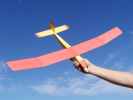 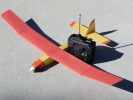
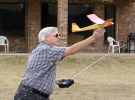 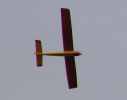 |
This is an original design electric powered sailplane called the
Termite. It has a 35" wing span with an area of 135 square inches. As
shown, the model weighs 7 ounces. It is powered with a direct drive Astro
Flight brushless 010 turning a prop made up of a Robbe hub and Graupner
4.7 x 2.3 CAM prop blades. The battery pack is an 8 cell 280 mah nimh
unit. The speed control is the Jeti brushless 06 that provides full proportional
throttle control. The model consistently gets 16 minute flights in no lift
conditions. An Adobe PDF version of the plan for this model is available
by clicking on this link. The plan prints
on legal size sheets (8.5" x 14"). |
|
   |
This is a 1998 version of a design that
appeared in Flying Models in the '50's. It is called the Guided Mite. This
was built by my brother Ralph. The original was
powered with a Cox PeWee .020 reed valve glow engine. The original was single channel
(rudder control) and had no throttle control. The model in the picture has an 18"
wing span and is electric powered with three control channels (throttle, rudder, and
elevator). The power and radio system are the same as used in the 25" Esquire above. A
PDF copy of the original 1958 Guided Mite construction article can be found
here. |
|
   |
This is the 1998 Guided Mite being used in
2000 as a multi motor test bed. The total wing span is 18".
The goal was to see if a practical multi motor micro RC model could be flown successfully.
The Guided Mite had the single motor and prop removed and four pager motors were added to
the wing. Each pager motor has been fitted with a home built gear drive. The gear drives
feature ball bearings on 1mm shafts, and have a ratio of 4:1. As flown, the model weighs
4 oz. It uses a 6 cell 50 mah battery pack, a Tetra receiver, and two Hitec HS-50 servos.
The model flies very nicely although flight duration is fairly short at 1.5 minutes. |
|
  
  
 |
This is a smaller version of the
Guided Mite. It has a 14" wing span. The
wing can be separated into two halves. The model was developed to fit inside the same box
that is used to store the transmitter. In addition to the model and transmitter, the box
also contains a battery charger (upper right corner), and a field charging battery pack
made up of 10 1700 mah nicad cells. The bottom photo shows the storage box equipment tray
with the transmitter stored, the charger in the upper right corner, and the 10 cell field
charging battery. The charger is available from Bob Selman Designs . For charging 50 mah cells up to
7 in a pack, the Bob Selman charger is highly recommended. The basic configuration of this
model is balsa construction with clear doped Japanese tissue covering on the wings.
Control functions are throttle and rudder. The motor is a Kenway KRD-1 with a 4:1
planetary gear drive. The receiver is an FMA Tetra (AM), the speed control is a JMP-4, the
servo is a Hitec HS-50, and the battery pack is 4 150 mah cells. Duration with the 150 mah
cells is in excess of 10 minutes in light winds. Flying weight is 80 grams (2.8
ounces). The model can also be flown with 4 50 mah cells. With the 50 mah cells the weight
is 60 grams (2.1 ounces), and flight duration is 4.5 minutes. Bob Selman has drawn a plan
for the Guided Mite scaled to an 18" wing span. The plan can be downloaded by
clicking on the underlined text for either a DXF version, or a multi-legal sheet TIF zip
file version. DXF (73k) TIF(32k) |
|
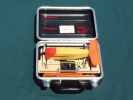 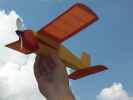
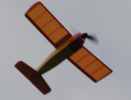 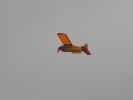 |
This is a revised version of the 14" Guided Mite shown above. This
model is the same size but incorporates elevator control and a revised
power set-up. The motor is a Mabuchi M-20 using a home made gear drive.
Power is supplied a 5 cell pack of 50 mah nicad cells. The prop is a
modified Gunther 5" unit. Duration is in the 5-7 minute range. |
|
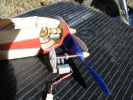 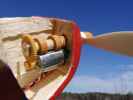 |
These pictures show the general arrangement of the gear drives that
have been built for models like the Guided Mite. They are designed to
"plug" into a snug fit hole in the model nose block. Placing the
spur gear at the rear allows the motor to be run in the normal rotation
direction, and makes it easier to fit the motor assembly into a narrow
nose configuration. Motor combinations can be easily swapped out by simply
"unplugging" one motor and pushing another into the snug fit
nose block opening. |
|
 
   |
Another original design model. This one is intended for
flying indoors. It has a wing area of 64 square inches and a total weight
of 42 grams. It is capable of nearly 10 minute flights using four 50 mah
cells. Both rudder and elevator controls are available via magnetic
actuators. Throttle control is also used. A unique feature of the model is
the use of the carbon fiber fuselage tube to also hold the gear drive spur
gear. This makes a very clean motor installation. The prop is a lightened
and size reduced 5" Gunther. The name of this model is the Corndog. |
|
 
  |
The Guided Mite designed by Bob Coon that first appeared in the April
1958 issue of Flying Models has been used as a development
platform for several projects. Here it is represented as a 14" span
micro flyer using magnetic actuators. A unique feature of the model is the
way the gear train has been installed. Instead of mounting the prop drive
gear assembly to the motor, it has been mounted directly on the fuselage.
The motor is in turn glued to the fuselage side in a position to optimize
the gear mesh. This arrangement made it very easy to set up a number of
different gear ratios for development. The model flies on 3 50 mah
nicad cells and weighs 34 grams. Flight duration is in the 7 minute range.
A full size plan on 8.5 x 11 paper in the Adobe PDF format can be down loaded by clicking on this link. |
|
 
  |
This is the Homeboy. It has been built as an all balsa model as well in
a version featuring a foam wing purchased from Bob
Selman Designs. This model is gets it's energy from a single 145 mah
Lithium Polymer cell. The motor is a Mabuchi M-20. The receiver is a JMP
narrow band micro unit and the actuators are from Bob Selman. It is a
great flyer indoors or outdoors. Small spaces are no problem for this
bird. Flying weight is 24 grams. |
|
 
|
Needless to say, the Guided Mite design is a favorite. This is the Micro Mite. This model has a wing span of 7 3/4 inches. It uses a direct
drive motor and a single 145 mah Lithium Polymer cell. Flying weight
is 15 grams. Performance is exhilarating.
It has very strong climb power and can do some great rudder/elevator
aerobatics. Electronics are again the JMP narrow band micro receiver and
Selman actuators. It won the smallest model to fly at the 2003
Barnstormers (club just north of Houston) electric fly-in. You can
download an Adobe PDF file containing the letter size plan for this model
by clicking on this link.
|
|
 
  |
In 2003 Ralph won the smallest model at the first annual Best Electrics
in Southeast Texas fly in. To defend his title in 2004 he built an even
smaller version of the profile Guided Mite. This version, called the MiMi
(Mini Mite), has a 5 inch wing span. It uses the same radio components as
the Micro Mite shown above. Power is provided by a 60 mah Lithium Polymer
cell. To help get a picture of the small size of this model and the
full fuselage version of the Micro Mite, both are shown stored in Ralph's
transmitter case. Also in the case are the transmitter, two LiPo chargers,
and a field charging battery. Building small sure does make travel easy.
The model's flying weight as shown is 9 grams. |
|
 
|
This is the Yardmaster. This model was built as a platform to evaluate
the emerging micro R/C components. The motor is a Mabuchi low volt M-20
coupled to a 4:1 planetary gear drive. The receiver is an RFFS-100 from Dynamic
Web Enterprises. This models uses magnetic actuators and gets power
from a single 145 mah lithium polymer cell.
|
|
 
|
The small profile Guided Mite shown just before the Yardmaster
demonstrated that a fairly small model can be made to fly quite
successfully, Given the success of that model, it was decided to build one
with the same wing span having a full fuselage. The full fuselage would
allow the equipment to be fully enclosed thereby reducing the model's
drag. The result is shown here. The same basic equipment is used. Fitting everything
inside the fuselage was a chore, but did get accomplished. The flying
weight went up to 22 grams, but she is still a good
flyer, but somewhat fast. You have to pay attention when flying this
model.
|
|
 

|
Shown here is a micro R/C Rogollo wing based original design
called the Cootie. The Rogollo wing was developed by a NASA engineer named
Frank Rogollo. This development took place back in the late 50's early
60's. It was intended to be used for a gliding return of space craft after
re-entering the atmosphere. The simplicity and light weight of the flexible
membrane wing took off like wildfire within the sport aviation community.
Probably the most familiar version of the Rogollo wing is the unpowered
hang glider. The Rogollo wing also makes a nice powered airplane layout.
This electric powered micro R/C version has throttle and rudder control.
With a flying weight of 18 grams, it flies nicely indoors or outdoors and has good control authority.
The motor is a Mabuchi M-20. The radio is a JMP micro unit driving a Bob
Selman mini magnetic actuator.
|
|
 
 
|
When you fly electric powered models, you are always looking for energy
sources that will give longer and longer flights. A long time dream has
been to build and fly a small pure solar powered model. Most solar powered
airplanes, models and full scale, use a large number of solar cells to
develop enough power to fly the airplane. The goal with this project was
to see how small a model could be built that would allow solar powered
flight without the presence of any batteries or other electricity storage
devices. Using the now familiar Guided Mite platform, the Sol Mite was
developed. The wing span for this model is 32". Power comes from
16 solar cells mounted in the wings. The cells are arranged to form two
banks of 8 in parallel that are in turn connected in series. Flying weight
is 144 grams. The motor is a GWS EDF 50 ducted fan motor with a gear
drive. The receiver is a JMP narrow band micro unit driving two standard
magnetic actuators from Bob Selman. The model flies nicely on bright sunny
days with little or no wind.
|
|
 
 
|
When the Sol Mite was developed it was hoped that a much smaller solar
powered model would one day be possible. In January 2007 Ralph realized that
goal. He successfully built a solar powered version of his Micro Mite. This
model has a 8" wing span and weighs 9.5 grams. Like the Sol Mite it does not
have any on board battery. It uses two high efficiency solar cells as the
power source. The radio is a Plantraco .38 gram three channel 900 mhz unit
that includes a built in speed control. Power comes from a 4 mm pager motor
combined with a home made 7.1:1 gear drive. The gears in the gear drive are
watch gears. Available power is quite good and gives the model a nice climb
rate. |
|
 
 
|
Ralph is always looking to make them smaller. When each effort to
shrink a model is always based on readily available components. His current
smallest model is the Sky Bug. It has a 3" wing span and weighs 3.5 grams.
It uses a Plantraco .38 gram 900 mhz receiver which controls throttle and
rudder. No elevator control is used on this tiny model. A 4mm pager motor is
used in a direct drive configuration. Energy comes from a 10 mah lithium
polymer battery. The batter is held in place with magnetic contacts that you
see in the right hand side photo of the model. If flies quite well but does
take some concentration due to the very small size. Also shown is a photo of
an earlier version of the Sky Bug in his transmitter carrying case along
with the current Sky Bug. The earlier version has a 4 3/4" wing span. |
|
 
 
|
When not building versions of the Guided Mite and very tiny models, other projects of
interest include the conversion of commercial flying products to electric
powered micro R/C models. Shown here is a Spin Master E-charger that
started life as a low cost electric powered Free Flight. When this
conversion was performed, the current crop of small light weight lithium
polymer cells were not yet readily available. As a result, the energy
source was a three cell 50 mah nicad battery pack. Home made magnetic
actuators were used to handle the control functions. The converted
E-charger proved to be a very successful micro R/C model. About the only
draw back to this particular model is the highly tapered wing. It is prone
to tip stalling. The current crop of micro R/C components opens the door
to many potential fun projects.
|
































































